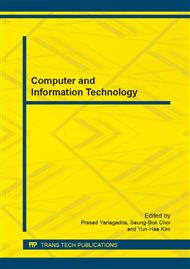[1]
Anderson, J. C., D. W. Gerbing, Structural Equation Modeling in Practice: A Review and Recommended Two-Step Approach. Psychological Bulletin. 103(3) (1988) 411-423.
DOI: 10.1037/0033-2909.103.3.411
Google Scholar
[2]
Bearden, W. O., J. E. Teel, Selected determinants of consumer satisfaction and complaint reports. Journal of Marketing Research (1983) 21-28.
DOI: 10.1177/002224378302000103
Google Scholar
[3]
Bhattacherjee, A., An empirical analysis of the antecedents of electronic commerce service continuance. Decision Support Systems. 32(2) (2001) 201-214.
DOI: 10.1016/s0167-9236(01)00111-7
Google Scholar
[4]
Bhattacherjee, A., Understanding information systems continuance: an expectation-confirmation model. MIS quarterly. 25(3) (2001) 351-370.
DOI: 10.2307/3250921
Google Scholar
[5]
Davis, F. D., Perceived usefulness, perceived ease of use, and user acceptance of information technology. MIS quarterly (1989) 319-340.
DOI: 10.2307/249008
Google Scholar
[6]
Davis, F. D., R. P. Bagozzi, P. R. Warshaw, User acceptance of computer technology: a comparison of two theoretical models. Management Science. 35(8) (1989) 982-1003.
DOI: 10.1287/mnsc.35.8.982
Google Scholar
[7]
Fishbein, M., I. Ajzen. Belief, attitude, intention and behavior: An introduction to theory and research. (1975).
Google Scholar
[8]
Gefen, D., D. W. Straub, Gender differences in the perception and use of e-mail: An extension to the technology acceptance model. MIS quarterly (1997) 389-400.
DOI: 10.2307/249720
Google Scholar
[9]
Kauffman, R. J., H. Lai, C. -T. Ho, Incentive mechanisms, fairness and participation in online group-buying auctions. Electronic Commerce Research and Applications. 9(3) (2010) 249-262.
DOI: 10.1016/j.elerap.2008.11.009
Google Scholar
[10]
Liao, S. -h., P. -h. Chu, Y. -j. Chen, C. -C. Chang, Mining customer knowledge for exploring online group buying behavior. Expert Systems with Applications. 39(3) (2012) 3708-3716.
DOI: 10.1016/j.eswa.2011.09.066
Google Scholar
[11]
Lu, Y., T. Zhou, B. Wang, Exploring Chinese users' acceptance of instant messaging using the theory of planned behavior, the technology acceptance model, and the flow theory. Computers in Human Behavior. 25(1) (2009) 29-39.
DOI: 10.1016/j.chb.2008.06.002
Google Scholar
[12]
Moore, G. C., I. Benbasat, Development of an instrument to measure the perceptions of adopting an information technology innovation. Information Systems Research. 2(3) (1991) 192-222.
DOI: 10.1287/isre.2.3.192
Google Scholar
[13]
Oliver, R. L., Cognitive, affective, and attribute bases of the satisfaction response. Journal of Consumer Research (1993) 418-430.
Google Scholar
[14]
Oliver, R. L., W. S. DeSarbo, Response determinants in satisfaction judgments. Journal of Consumer Research (1988) 495-507.
Google Scholar
[15]
Shiau, W. -L., M. M. Luo, Factors affecting online group buying intention and satisfaction: A social exchange theory perspective. Computers in Human Behavior (2012).
DOI: 10.1016/j.chb.2012.07.030
Google Scholar
[16]
Szymanski, D. M., D. H. Henard, Customer satisfaction: a meta-analysis of the empirical evidence. Journal of the academy of marketing science. 29(1) (2001) 16-35.
DOI: 10.1177/009207030102900102
Google Scholar
[17]
Taylor, S., P. Todd, Assessing IT usage: The role of prior experience. MIS quarterly (1995) 561-570.
DOI: 10.2307/249633
Google Scholar
[18]
Taylor, S., P. A. Todd, Understanding information technology usage: A test of competing models. Information Systems Research. 6(2) (1995) 144-176.
DOI: 10.1287/isre.6.2.144
Google Scholar
[19]
Tsai, M. -T., N. -C. Cheng, K. -S. Chen, Understanding online group buying intention: the roles of sense of virtual community and technology acceptance factors. Total Quality Management & Business Excellence. 22(10) (2011) 1091-1104.
DOI: 10.1080/14783363.2011.614870
Google Scholar
[20]
Venkatesh, V., Determinants of perceived ease of use: Integrating control, intrinsic motivation, and emotion into the technology acceptance model. Information Systems Research. 11(4) (2000) 342-365.
DOI: 10.1287/isre.11.4.342.11872
Google Scholar
[21]
Venkatesh, V., F. D. Davis, A theoretical extension of the technology acceptance model: four longitudinal field studies. Management Science. 46(2) (2000) 186-204.
DOI: 10.1287/mnsc.46.2.186.11926
Google Scholar
[22]
Wu, I. -L., J. -L. Chen, An extension of trust and TAM model with TPB in the initial adoption of on-line tax: an empirical study. International Journal of Human-Computer Studies. 62(6) (2005) 784-808.
DOI: 10.1016/j.ijhcs.2005.03.003
Google Scholar


